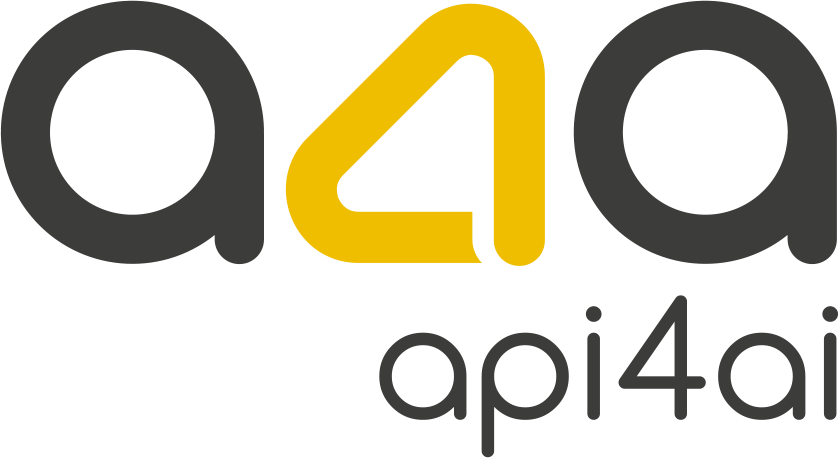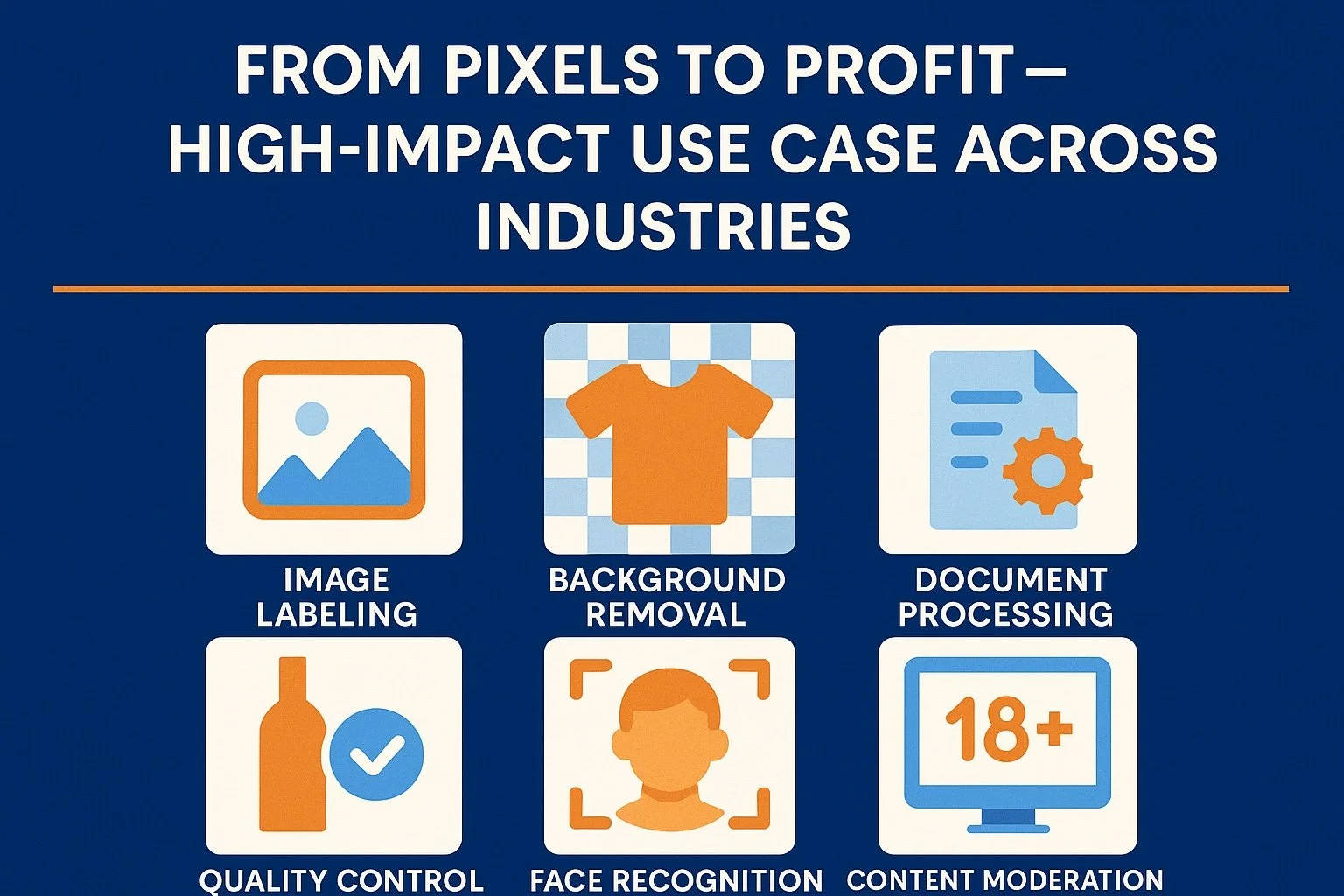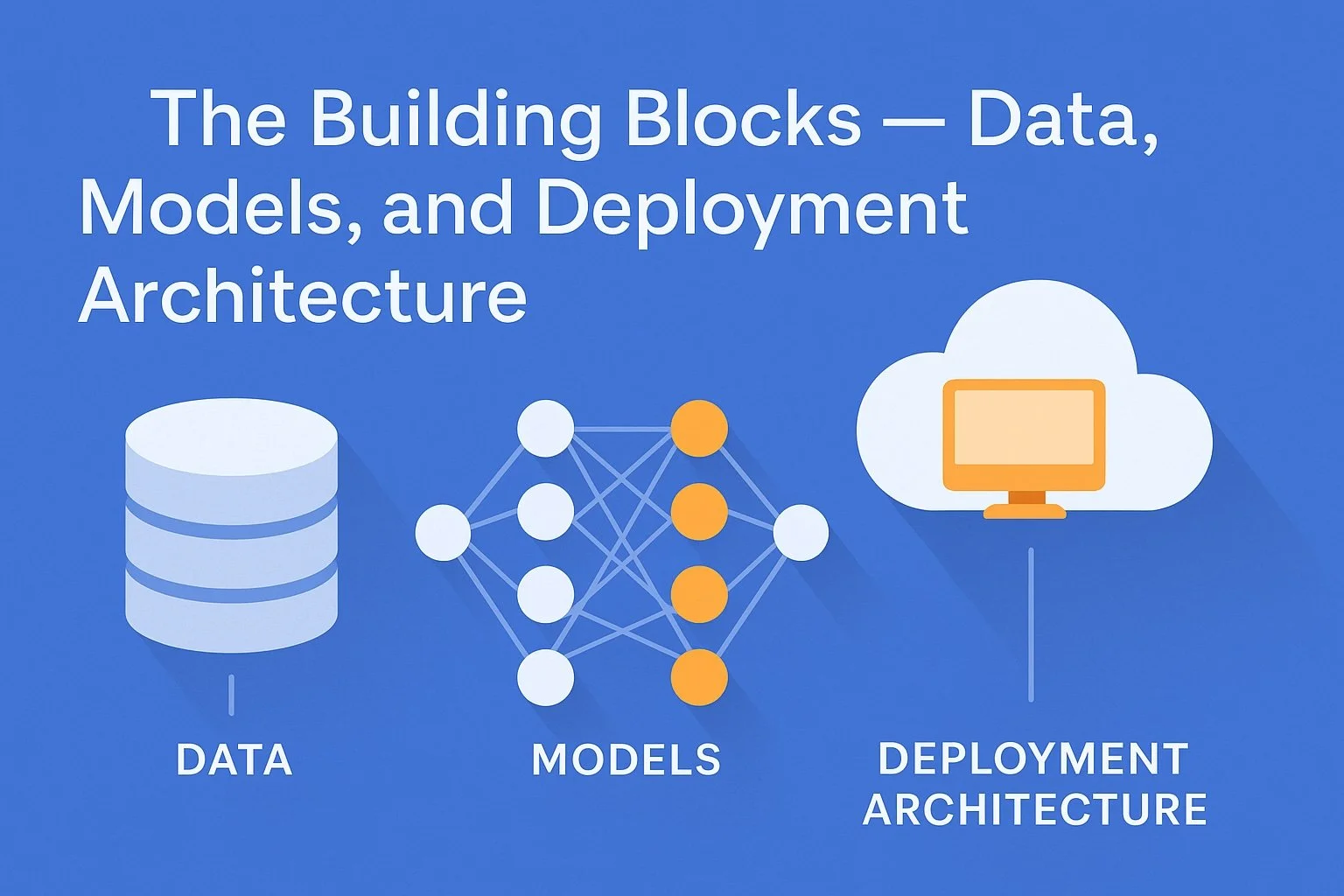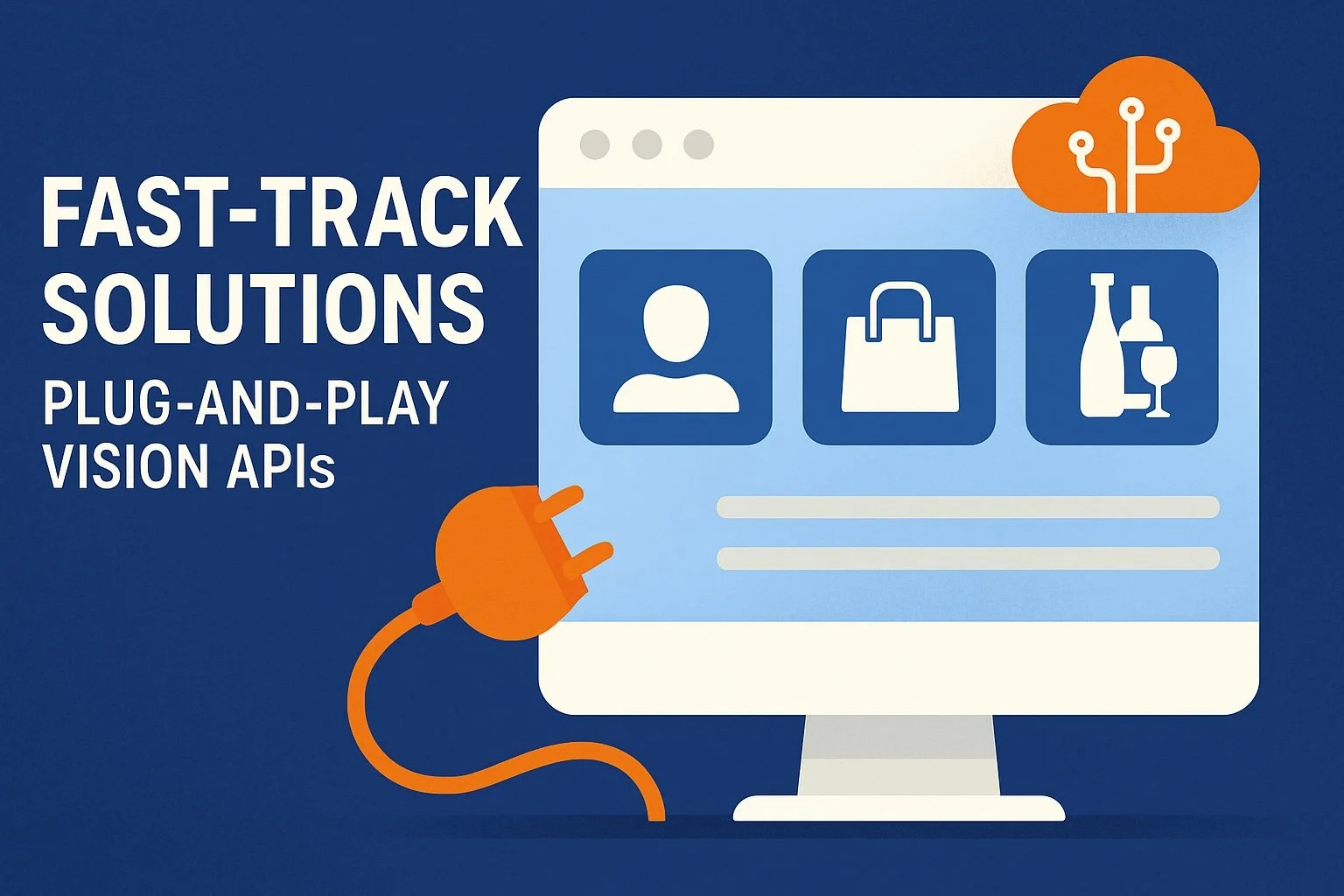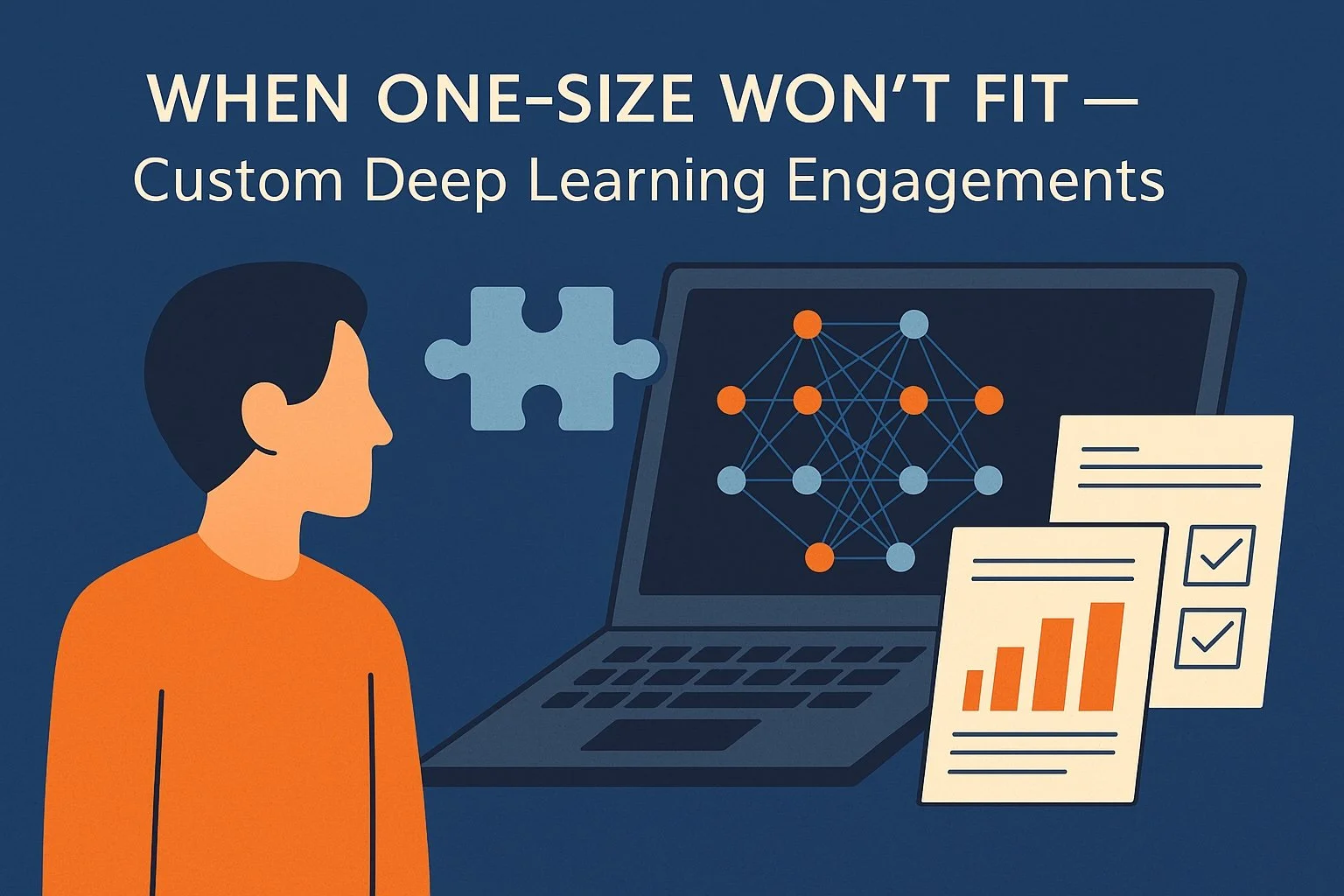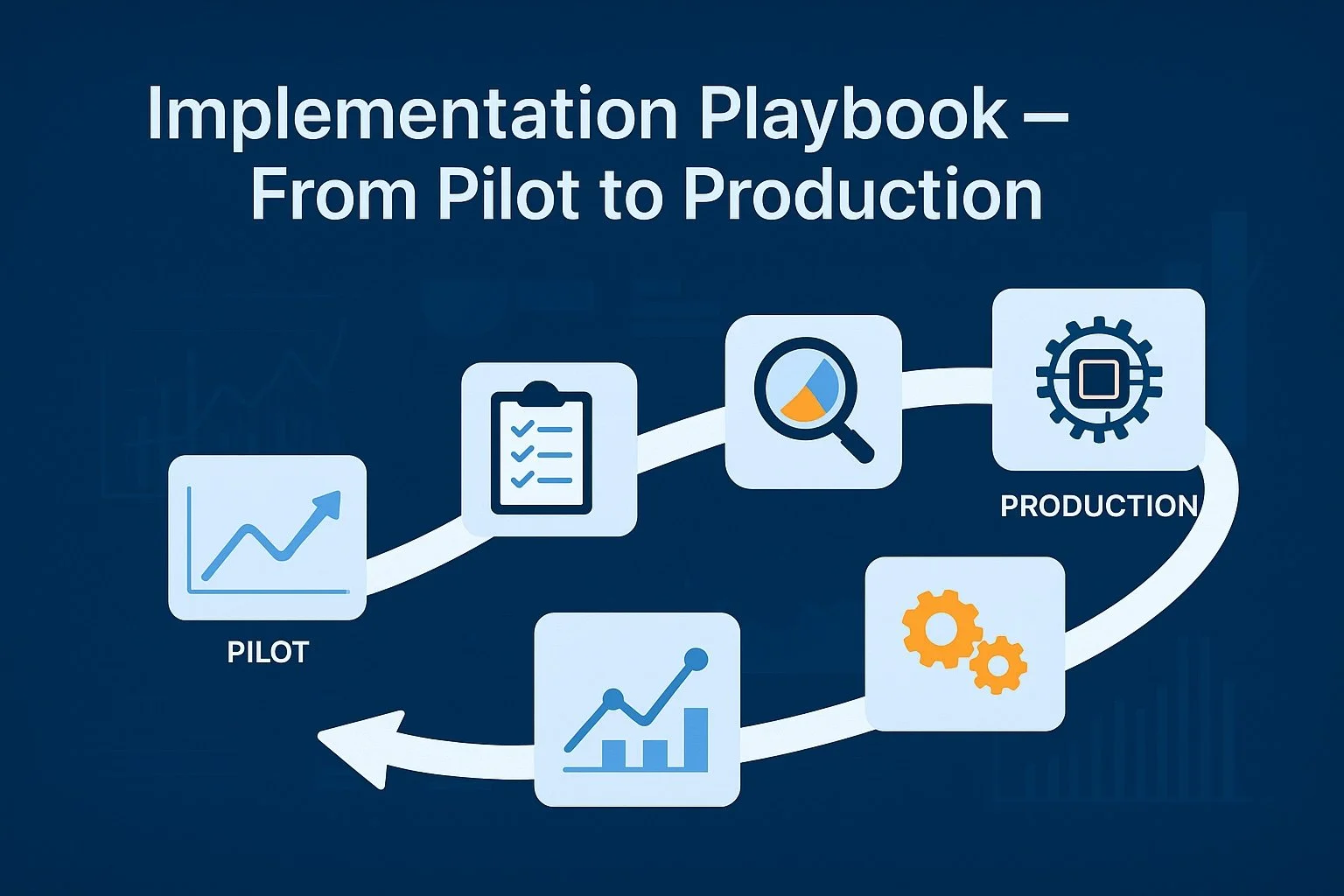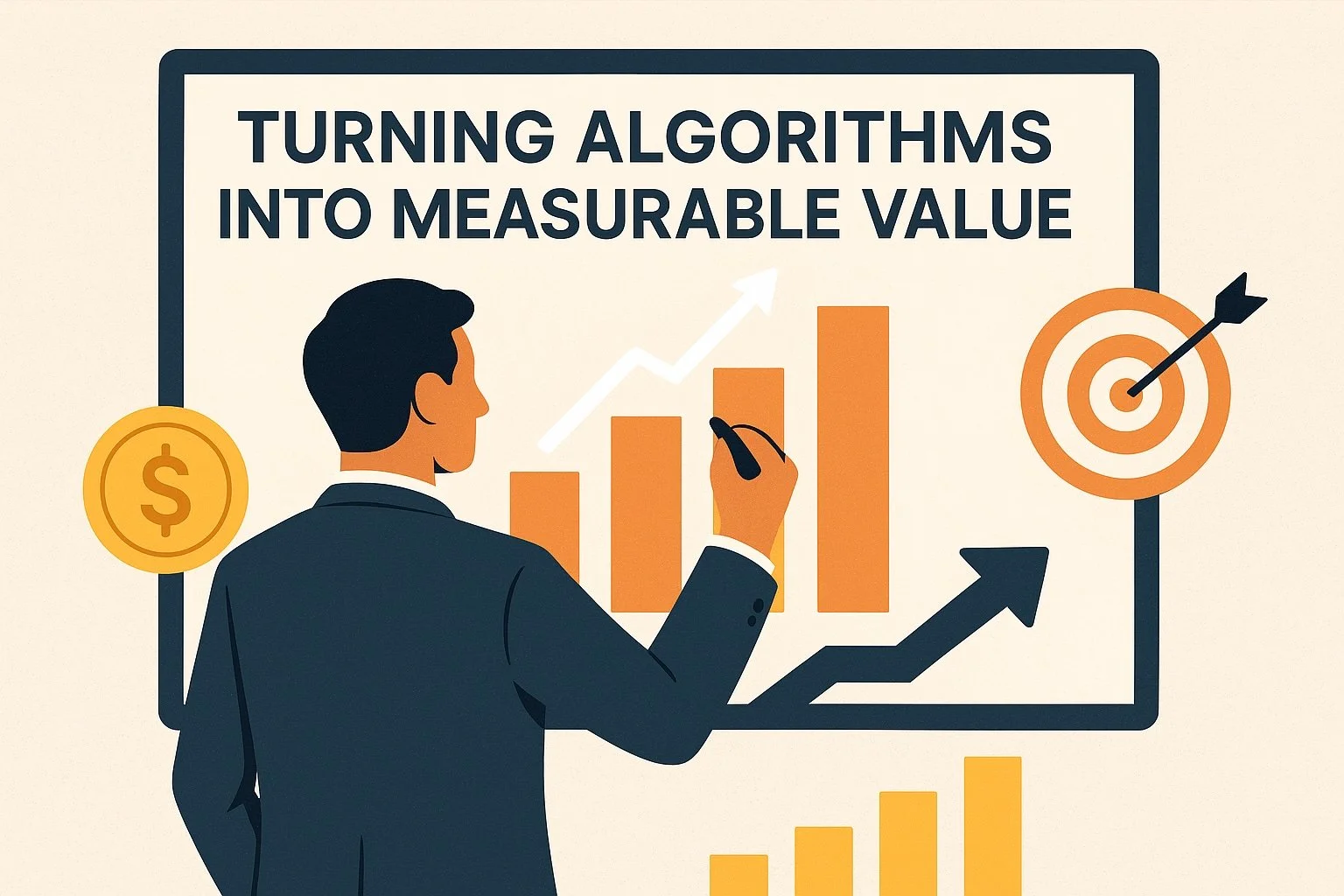How Deep Learning Solves Real Business Problems
Introduction — Why Deep Learning Matters in 2025
Deep learning is no longer just a buzzword or a futuristic technology discussed in research labs. In 2025, it’s a proven tool that solves real-world business problems every day — across industries like retail, logistics, finance, manufacturing, and even agriculture.
At its core, deep learning is a branch of artificial intelligence (AI) that allows machines to recognize patterns in large amounts of data — especially images, videos, and text. What makes deep learning especially powerful is its ability to improve with more data, learning directly from examples instead of relying on fixed rules. This makes it ideal for handling messy, complex tasks like recognizing objects in a photo, reading handwritten documents, or spotting defects in a product image.
What’s changed in recent years is accessibility. Thanks to cloud platforms, pre-trained models, and ready-to-use APIs, companies no longer need large data science teams or expensive infrastructure to benefit from deep learning. Today, even small and mid-sized businesses can integrate intelligent features into their software — like automatically removing backgrounds from product photos, detecting inappropriate content, or identifying logos in social media posts.
Moreover, market trends show that deep learning isn’t just about efficiency. It’s also about competitive advantage. Businesses that adopt AI early tend to innovate faster, personalize better, reduce costs, and open up entirely new revenue streams. According to leading industry reports, the global AI market is growing at double-digit rates year over year, and visual AI — powered by deep learning — is one of the fastest-growing segments.
This blog post will explore how deep learning delivers real value across different industries, what technologies make it work, and how companies can start using it effectively — whether through off-the-shelf APIs or tailored solutions built to meet specific business needs.
From Pixels to Profit — High-Impact Use-Cases Across Industries
Deep learning is especially powerful when it comes to working with visual data like photos, videos, or scanned documents. This is where it can solve problems that were once time-consuming, expensive, or even impossible to tackle manually. Let’s look at how different industries are already using deep learning to solve real business challenges — and how these use-cases turn into measurable value.
Retail & eCommerce
Online retailers handle thousands of product images — and consistency is key to delivering a good shopping experience. Deep learning helps by:
Automatically removing backgrounds from product photos to create clean, professional-looking listings.
Recognizing product categories through image labeling, so items are correctly sorted and searchable.
Detecting logos and brands in user-generated content for influencer campaigns or reviews.
👉 Example: An online marketplace can use a Background Removal API and Image Labeling API to process seller photos instantly, improving product discovery and visual appeal.
Manufacturing & Logistics
In factories and warehouses, visual checks are important — but relying on human workers can lead to missed defects or inconsistencies. Deep learning can:
Detect defects on assembly lines using real-time image analysis.
Track objects and packages in motion for inventory control or shipment verification.
Measure wear or damage on equipment parts to support preventive maintenance.
👉 Example: A production line can integrate an Object Detection API to identify missing or misplaced components before they reach packaging.
Finance & Insurance
Financial companies deal with large amounts of paperwork and visual data. Deep learning allows them to:
Extract text from receipts, invoices, and ID documents using OCR (optical character recognition).
Verify customer identities with face detection and comparison.
Assess damages from accident photos for fast insurance claims processing.
👉 Example: A fintech app could combine OCR API and Face Detection API to automate onboarding and document verification.
Media & Entertainment
With user-generated content growing rapidly, deep learning helps keep platforms clean and brand-safe. It can:
Identify NSFW (not safe for work) content and flag it for moderation.
Recognize brand logos in photos or videos for analytics and ad targeting.
Anonymize faces or license plates for privacy in public footage.
👉 Example: A social media tool might use a NSFW Recognition API and Image Anonymization API to automatically moderate uploaded images.
Healthcare & Agriculture
Even outside traditional tech fields, deep learning is solving practical problems:
In healthcare, it helps analyze medical images like X-rays or skin photos to assist diagnosis.
In agriculture, it can identify crop diseases or monitor livestock health using drone or smartphone images.
👉 Example: A farming analytics platform might train a custom model using similar techniques found in off-the-shelf object recognition APIs to monitor crops remotely.
These examples show that deep learning is not just about fancy algorithms — it’s about solving problems that matter. Whether you need faster processes, fewer errors, or new insights from visual data, deep learning offers a practical path to improvement. And with cloud-based APIs and custom development options available, getting started has never been easier.
The Building Blocks — Data, Models, and Deployment Architecture
Behind every successful deep learning solution, there are a few key building blocks working together: quality data, the right model, and a solid deployment setup. Understanding how these pieces fit together is essential for turning a business idea into a working AI system.
1. Data: The Foundation of Deep Learning
Deep learning systems learn by example — and that means data is everything. If your data is messy, incomplete, or biased, even the most advanced models won’t perform well. Here’s what makes good data:
Diversity and volume: More data from different scenarios helps models learn to generalize. For example, a model recognizing furniture needs to see different angles, colors, and lighting conditions.
Accurate labeling: Each image must have the correct tags or annotations. A model trained with mislabeled images will make more mistakes.
Augmentation techniques: When real data is limited, techniques like flipping, rotating, or changing brightness can help create variations and improve learning.
Synthetic data: In some cases, computer-generated images are used to simulate real-world conditions (e.g., rare defects, edge cases).
2. Models: Choosing the Right Architecture
A model is the "brain" that interprets your data. Different tasks and environments require different types of models:
Convolutional Neural Networks (CNNs): The traditional choice for image tasks like classification and detection. They’re fast and efficient for many use-cases.
Vision Transformers (ViTs): A newer type of model that often performs better on large and complex datasets, especially when accuracy is critical.
Lightweight models: These are designed for use on edge devices like phones or cameras, where power and speed matter more than perfect accuracy.
Choosing a model is a balance:
If speed is more important than precision (like real-time detection), a simpler model may be better.
If the task is highly sensitive (like medical imaging), more advanced architectures may be worth the cost.
3. Deployment: Making AI Work in the Real World
Once a model is trained, it needs to be deployed — which means making it available to users, systems, or devices. There are several ways to do this:
Cloud deployment: The easiest and most flexible option. The model runs on remote servers and is accessed through an API. This is ideal for apps that need scalable, always-updated intelligence.
Edge deployment: The model runs on a local device (like a phone or industrial camera). This is useful when internet access is limited or fast response is needed without delay.
Hybrid setup: Combines both — for example, a model runs basic checks on the device and sends complex cases to the cloud.
4. MLOps: Keeping Things Running Smoothly
Machine Learning Operations (MLOps) refers to the tools and processes used to manage AI systems over time. Key components include:
Model versioning: Keeping track of changes and updates to avoid confusion or errors.
Monitoring: Checking performance in the real world — is the model still accurate? Is it slowing down?
Retraining: Updating the model as new data becomes available or when behavior shifts (called “model drift”).
By bringing together good data, the right model, and an efficient deployment strategy, businesses can create deep learning solutions that are not just smart — but also practical, reliable, and ready for the demands of the real world. Whether through cloud APIs or custom solutions, these building blocks are what turn AI from a concept into real business value.
Fast-Track Solutions — Plug-and-Play Vision APIs
For many businesses, building a deep learning solution from scratch can seem overwhelming. It takes time, resources, and specialized knowledge. But what if there was a way to access the power of deep learning without building everything yourself?
This is where ready-to-use vision APIs come in. These are cloud-based tools that let companies tap into pre-trained deep learning models through a simple API — just like using a weather forecast or payment system in an app. With a few lines of code, you can connect your product or workflow to powerful AI features, without needing to train or maintain the models yourself.
What Makes Vision APIs So Effective?
Here are the key benefits that make pre-built vision APIs a smart choice for many companies:
Quick integration: Vision APIs are designed for developers. They come with clear documentation, code samples, and SDKs to help you get started fast.
No need for infrastructure: You don’t need to buy servers or hire a team of data scientists. Everything runs in the cloud.
Scalable and reliable: Whether you're processing 100 images a day or 10,000, cloud APIs automatically scale to meet demand.
Always up to date: The provider maintains and improves the model in the background, so you always use the latest version.
Common API Use-Cases That Solve Real Problems
Vision APIs are used in many real-world applications. Here are some common and useful types:
OCR (Optical Character Recognition): Extracts text from scanned documents, receipts, ID cards, and more. Great for automating data entry.
Background removal: Deletes the background from product or portrait images to improve visual presentation.
Object detection: Finds and tracks specific items in an image, like cars, packages, people, or tools.
Image labeling and classification: Automatically identifies what’s in a photo and assigns labels like “chair,” “sofa,” or “lamp.”
Face detection and recognition: Finds faces in an image and compares them for identity verification or analytics.
Logo and brand recognition: Detects brand marks in social media photos or videos — useful for sponsorship tracking and market research.
NSFW detection: Flags images with inappropriate or adult content to support safe content platforms.
Image anonymization: Blurs faces or license plates to protect privacy in videos or public camera feeds.
Examples of Solving Business Tasks with Vision APIs
Let’s see how this works in action:
An e-commerce platform wants to clean up seller-uploaded photos. By using a Background Removal API, it can instantly remove messy backgrounds and standardize product images.
A logistics company needs to read labels from delivery photos. With an OCR API, it can extract text like tracking numbers or addresses without manual input.
A brand marketing team wants to know where their logo appears online. A Brand Recognition API helps scan user-generated content for logos in photos or videos.
A real estate app wants to improve search by tagging furniture in room photos. It can use an Image Labeling APIand a Furniture Recognition API together to understand image content and enrich listings.
Vision APIs are especially useful for businesses that want fast results with minimal effort. They reduce the cost and complexity of using deep learning while delivering real impact. For many companies, this is the easiest way to begin using AI — and a great first step before considering custom solutions later down the road.
When One-Size Won’t Fit — Custom Deep Learning Engagements
While ready-to-use vision APIs are a great starting point, they’re not always enough. Every business has unique challenges, and sometimes those challenges require a custom-built deep learning solution. Whether it's a highly specific task, an unusual dataset, or the need for full control, custom development offers the flexibility to create exactly what your business needs.
Why Off-the-Shelf Isn’t Always Enough
Pre-built APIs are trained on general-purpose datasets. This means they work well for common tasks like reading printed text or detecting standard objects. But what happens when your use case is more specialized? For example:
Your product has a unique appearance that isn’t found in public datasets.
You use images from industrial equipment or medical devices that look very different from everyday photos.
You need the model to follow very specific business rules or handle niche categories.
In these situations, custom models are the answer. They can be trained specifically for your environment, your data, and your goals — leading to better performance and more useful results.
Business Advantages of Custom Deep Learning Solutions
Creating a tailored solution may seem like a big investment, but it often pays off in the long term. Here’s why:
Higher accuracy: A model trained on your data performs better and understands your edge cases.
Competitive edge: You get a solution that your competitors don’t have, which can give you a significant market advantage.
Cost reduction over time: Although development takes effort upfront, it can replace manual work, reduce errors, and improve automation — saving money in the long run.
Full control and adaptability: You decide how the model behaves, how it’s updated, and how it integrates into your systems.
When to Choose a Custom Model
You should consider a custom solution if:
You’ve tried off-the-shelf APIs and found they don’t meet your accuracy or feature needs.
Your images are from a highly specific domain (like electronics, agriculture, or specialized manufacturing).
You need to support multiple languages, complex layouts, or local compliance rules.
You want to embed the model into a unique workflow or application that requires close integration.
Often, companies start with an API to test an idea quickly. If the concept works but needs more precision or flexibility, they move to a custom model. This hybrid approach is cost-effective and low-risk.
What Custom Development Looks Like
A typical custom deep learning project follows these steps:
Discovery workshop: Understand the business problem, goals, and data availability.
Data collection and labeling: Gather images and create accurate labels or annotations.
Model design and training: Build and train a deep learning model using your data.
Testing and validation: Check how well the model works in real scenarios and refine it.
Integration and deployment: Connect the model to your systems via API or local software.
Ongoing support: Monitor the model’s performance and update it as needed.
👉 Example: A company that inspects circuit boards may need a custom model trained to detect very specific defects — such as tiny soldering issues that general-purpose object detection models wouldn’t recognize. A tailored solution trained on high-resolution images from their actual production line will deliver far better results.
Custom deep learning is about building AI around your business, not the other way around. With the right strategy, it becomes a powerful tool for efficiency, accuracy, and innovation — helping companies solve problems that off-the-shelf tools simply can’t handle.
Implementation Playbook — From Pilot to Production
Bringing deep learning into your business isn’t just about using smart technology — it’s about making sure that technology delivers real results. Whether you're using a ready-to-go API or building a custom solution, success depends on a clear, step-by-step approach.
This section outlines a simple implementation playbook — a roadmap that helps turn ideas into working, valuable solutions.
Step 1: Define the Problem and Set Clear Goals
Before doing anything technical, you need to answer key questions:
What business challenge are you solving?
What type of visual data do you have — images, videos, documents?
What would success look like? (e.g., 90% accuracy, 50% time saved, fewer manual errors)
Having clear KPIs (key performance indicators) helps you stay focused and measure progress later.
Step 2: Audit and Prepare Your Data
Great results require great data. Start by collecting a sample of the images or files you’ll be working with. Then:
Check the quality: Are the images clear, well-lit, and consistent?
Organize them by category or task: For example, “damaged vs. undamaged” or “label types A, B, and C.”
Label the data properly: Use accurate tags or annotations so the model knows what to learn.
In many cases, just 20–30% of your data will represent the most useful examples — so focus on cleaning and curating that core set first.
Step 3: Start with a Fast Pilot Using Cloud APIs
Before investing in custom development, run a small experiment using a vision API. For example:
Use an OCR API to extract text from receipts.
Try an Object Detection API to identify items in warehouse photos.
Use a Face Detection API for basic identity verification.
This helps test your idea quickly and provides real performance data. If the API meets your needs — great. If not, you’ve still learned what to improve.
Step 4: Iterate and Improve Based on Results
Once you’ve tested a basic version, you can improve it by:
Collecting more examples, especially edge cases where the model made mistakes.
Adjusting image quality, lighting, or labeling to reduce confusion.
Fine-tuning or retraining the model (if you’re going the custom route).
This step is all about learning from real feedback and making the system better over time.
Step 5: Deploy Securely and Integrate with Your Workflow
Now it’s time to move from testing to production. This means:
Choosing the right deployment method: Cloud, Edge, or Hybrid.
Ensuring data security — especially if you’re processing faces, license plates, or documents. APIs like Image Anonymization can help protect privacy.
Connecting the solution to your internal systems, whether it’s a website, app, or dashboard.
Tip: Build an interface (even a simple one) so non-technical team members can use or monitor the AI output easily.
Step 6: Monitor, Maintain, and Scale
AI is not “set it and forget it.” You need to:
Monitor performance: Are accuracy and speed holding up? Are new image types confusing the model?
Collect new data: Keep updating your dataset with fresh examples.
Retrain when needed: If the model’s performance drops, schedule retraining or model updates.
Also, keep an eye on business metrics — is the solution saving time, reducing errors, or helping generate more revenue?
By following this playbook, businesses can move from simple experiments to full-scale, working AI systems. The process isn’t magic — it’s structured, manageable, and most importantly, repeatable. Whether you're starting small with an API or building a custom model from the ground up, these steps help ensure your deep learning solution actually delivers value.
Conclusion — Turning Algorithms Into Measurable Value
Deep learning is no longer just a futuristic concept — it's a practical, proven way to solve real business problems. From automating document processing and moderating content to detecting product defects or recognizing logos in images, deep learning is already transforming how companies work, serve customers, and grow.
But success with AI doesn't come from technology alone. It comes from a clear strategy — understanding your goals, choosing the right tools, and building smart workflows around them. The good news is that you don’t have to start from scratch. With the rise of cloud-based vision APIs, businesses of all sizes can experiment, validate ideas, and unlock value in weeks instead of months. And when off-the-shelf tools aren’t enough, custom deep learning solutions can take you even further — tailored to your data, your challenges, and your vision.
Getting started is easier than ever:
Identify a visual task in your business that takes too much time or causes too many errors.
Try a fast proof-of-concept using APIs for OCR, object detection, background removal, or face recognition.
If needed, scale to a custom model with expert help and a clear long-term ROI plan.
The future of deep learning isn’t just about smarter algorithms — it’s about using those algorithms to create real-world impact. Companies that act now can improve efficiency, cut costs, unlock new services, and build competitive advantages that last.
In a world where visual data is everywhere, the question is no longer “Should we use deep learning?”
It’s “What problem should we solve first?”
